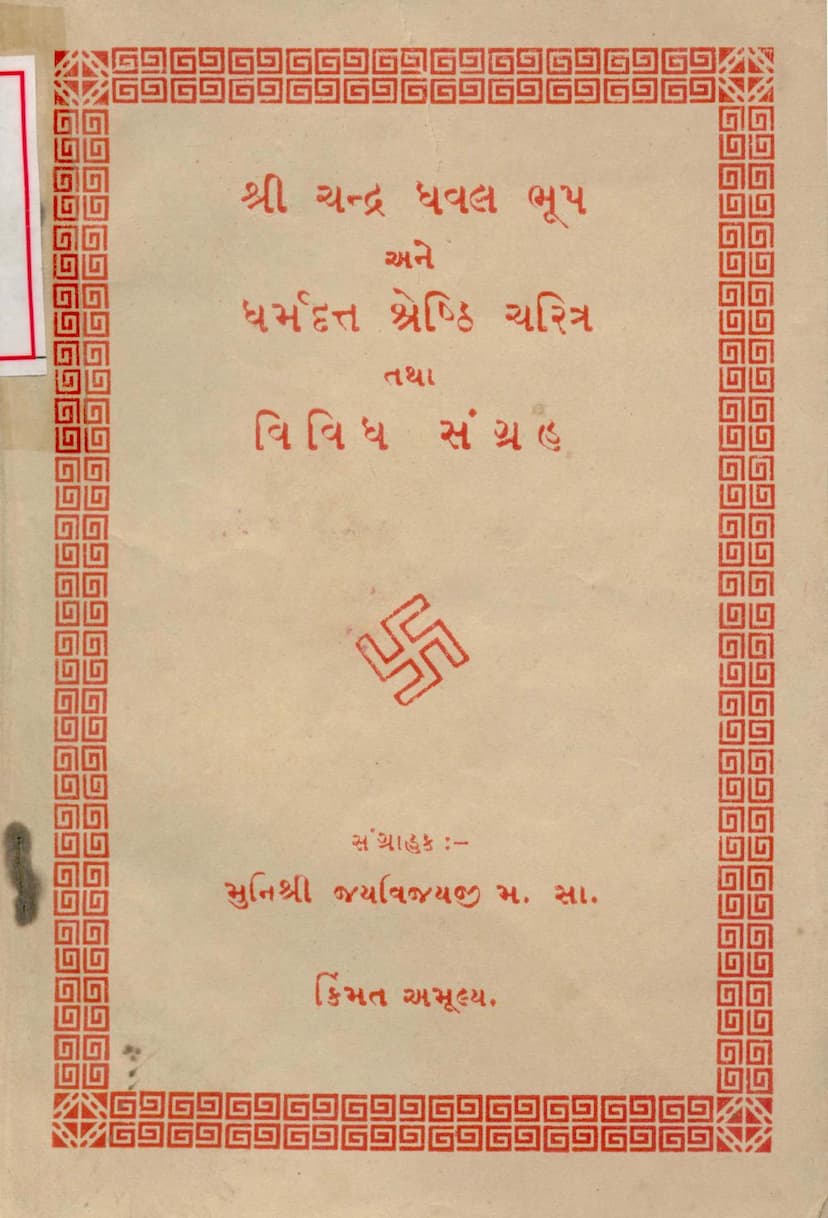Chandra Dhaval Bhupv Evam Dharmdatt Shreshthi Charitra Tatha Vividh Sangraha
Added to library: September 1, 2025

Summary
The Jain text titled "Chandra Dhaval Bhup Evam Dharmdatt Shreshthi Charitra tatha Vividh Sangraha," compiled by Muni Shri Jayvijayji, tells the stories of King Chandra Dhaval and the merchant Dharmdatt, along with various other compilations. The book aims to guide individuals towards spiritual upliftment and the ultimate goal of liberation (moksha) through righteous living.
The narrative begins with the story of King Chandra Dhaval, who, despite being knowledgeable and skilled in divination, encounters a mysterious event involving a golden man in a cremation ground. His father, King Yash Dhaval, receives a report of a man covered in dust and with torn clothes claiming theft. The king, embodying the principle of royal refuge for the needy, summons this man. The man claims a golden man has been stolen, and the king, deeming him unsuitable for possessing such wealth due to his appearance, investigates further.
The second major narrative focuses on Dharmdatt Shreshthi (merchant). A wealthy merchant named Shreepati and his wife Shrimati are distressed by their childlessness. Shreepati's friend, Dharmadhan, advises against relying on mere rituals and emphasizes the importance of true dharma. The story illustrates this through the example of Devsharma, who vowed to build a temple if blessed with a son, named him Devdatt, and fulfilled his promise. However, Devdatt's life is tragically cut short due to his father's misguided actions.
The text then delves into Dharmdatt's own life, highlighting his journey from a virtuous upbringing to being influenced by negative company. Despite his father's efforts to guide him, Dharmdatt falls prey to gambling and visits a courtesan. When his father faces financial ruin, Dharmdatt, initially unrepentant, eventually seeks solace in his wife, who supports him. He embarks on a sea voyage to earn wealth but faces a shipwreck. He is rescued by a fierce rakshasa (demon) and encounters a divine maiden. This maiden, Dhanvati, from Sinhaldweep, was betrothed to Dharmdatt based on astrological compatibility. Their reunion is fraught with peril, but Dharmdatt, with the maiden's assistance, overcomes the rakshasa.
Their journey continues, leading them to Jain temples and a life dedicated to dharma. They face further trials, including Dhanvati's disappearance and Dharmdatt's subsequent despair. He encounters a yogi who promises to help him find a "golden man" through occult practices. Dharmdatt, discerning the yogi's malicious intent, defeats him and transforms the yogi into a golden man.
The narrative then connects King Chandra Dhaval and Dharmdatt. King Chandra Dhaval, seeking the golden man, is presented with the one created by Dharmdatt. Both men achieve wealth and recognition. The story emphasizes the role of dharma and righteous conduct in achieving prosperity and spiritual fulfillment.
A significant portion of the text is dedicated to philosophical discussions on the nature of happiness, the soul's true nature, and the path to liberation. It highlights that true, eternal happiness (atyantik and ekantik sukha) lies within the soul and cannot be found in material possessions or worldly pleasures. The text stresses the importance of right knowledge (samyak gyan), right faith (samyak darshan), and right conduct (samyak charitra) as the means to overcome suffering and attain liberation. It emphasizes that attachment and aversion are the root causes of suffering, and their eradication leads to ultimate bliss.
The text includes various illustrative anecdotes and parables, such as the story of the Bhil king and his three queens, a scholar's witty answers to four questions, and a loyal accountant's advice to his employer's son. These stories further reinforce the moral and spiritual lessons embedded in the narratives of Chandra Dhaval and Dharmdatt.
The final chapters discuss the essence of dharma, highlighting the significance of charity, virtue, penance, and contemplation. It emphasizes that true wealth is not material but lies in spiritual development and detachment. The text concludes by underscoring that consistent practice of dharma, coupled with a righteous life, ultimately leads to liberation and the eternal bliss of the soul. The stories of Dharmdatt and Chandra Dhaval serve as exemplars of this spiritual journey, demonstrating the consequences of both virtuous and flawed actions.